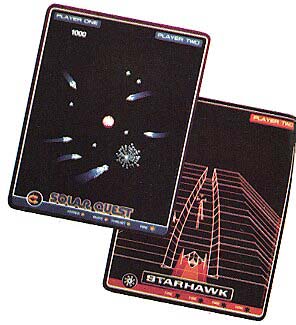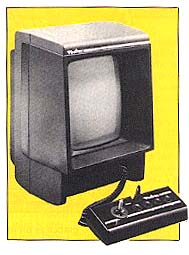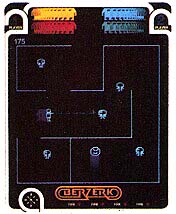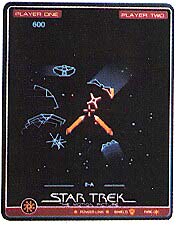
|
THE VECTREX
ARCADE SYSTEM
From General Consumer Electronics
By David H. Ahl
Not another one," said Derek.
"But this is different," I said. "It uses vector graphics. "
"Vector, shmector, what's the difference? What we need are some new games, not new graphic systems."
That, more or less, was the gist of my conversation with Derek after returning from the summer Consumer Electronics Show. I was enthusiastically describing the Vectrex Game System and he was anything but enthusiastic.
Now, five months later, we have our hands on an actual machine. Derek could be reached for comments only between plays of Scramble and Berzerk. His comments were along the line of, "Wow! This is fantastic! Look at that explosion! I don't believe it! It's like a coin-op!"
Yes, folks, Vectrex is all of those things. Vector graphics really do make a difference, and the strong line-up of games helps immensely.

|
The Vectrex Box
Vectrex is a self-contained system housing a microprocessor and display. A small control panel toward the bottom hinges forward and lifts off. This is connected to the unit by means of a coiled telephone-type cable which can be stretched to about two feet. The box itself is 9" wide x 14" high x 11" deep. A slot for a plug-in cartridge is on the right side. The rectangular 6" x 8" screen is vertically aligned, opposite to most TV sets but similar to many coin-op arcade games.
There are just two controls on the box itself, an off-on switch/volume control and a reset button. The control panel has a potentiometer-type joystick at the left and a row of four pushbuttons at the right. The joystick handle is only 3/4" long, one of the shortest we have seen in our evaluations of game machines and joysticks. The pushbuttons are 0.6" in diameter and have an extremely short throw, providing very rapid response to firing, thrusting, dropping bombs, etc.
Although we initially had reservations about the joystick because of its small size, it turns out that it gives the player good, precise control of objects on the screen and is easily manipulated by holding it between the thumb and forefinger of the left hand.
Left hand? Yes. Right-handed players might feel that the joystick should have been placed on the right of the control panel, with the buttons on the left. However, the righties on our play testing panel did not seem to mind having to adjust to moving the joystick with their left hands.
There is a place on the front of the box to plug in a second controller, however, we did not have one, so our tests were done with just one.
Vector Graphics
What are these vector graphics about which Derek was so unenthusiastic until he saw them?
Perhaps it is best to describe "ordinary" raster scan graphics first. Raster scan graphics are found on most TV sets and video monitors. A picture is generated by an electron beam scanning from left to right across the face of the tube 525 times in 1/30 of a second. For each point on the screen (pixel), the electron gun in the CRT is given a signal by the computer to either light or not light that pixel. In the case of a monochrome signal, there is just one electron gun, while in the case of a color signal there are three guns (red, green, and blue).
To move an object on the screen (animation) the old object is "erased" (the pixels defining it are turned off) and the object is illuminated in a slightly different position. If the two objects (the one being erased and the new one being drawn) are close together, the effect is one of continuous movement. This movement takes place at the rate of 30 frames per second, plenty fast for good animation in computer and coin-op games.
Vector graphics, on the other hand, use a "refresh" type of CRT tube. In this type of tube, the electron gun, does not sweep across the entire tube turning the pixels on and off. Rather, the gun moves from the beginning to the end of a line segment and energizes (lights) the phosphor in between. The associated electronics keep this segment lit until another signal comes along which says, in effect, "turn it off."
Since the electron gun is not regenerating the entire picture every 1/30 of a second, but rather going to only those points which are changed from the previous picture, much quicker animation and movement is possible. Furthermore, objects on the screen appear much crisper than in a raster scan system. In effect, the screen appears to be drawn by an extremely fine-line plotter with very high resolution.
At this point, affordable vector graphic technology is limited to monochrome displays, and that is what is found in the Vectrex Arcade System. Color is provided by a device which Odyssey used on the very earliest video game systems, namely translucent plastic overlays which pop in front of the screen. In some cases (Mine Storm, Berzerk, and Clean Sweep) these displays are all one color, while in other games up to three colors are found on the overlays.
On most self-contained game systems, sound is provided by a series of electronic boops and beeps and buzzes. Not so on the Vectrex system. The sound rivals that of the best computer and coin-op games and, in several cases, even includes music.
So the hardware is impressive; what about the games?
Mine Storm
Mine Storm is an adaptation of, dare, we say it, Asteroids Deluxe. The game is built into the basic Vectrex system, and it automatically appears upon power-up.
You start with a small space ship at the center of the screen. Yes, a ship, not a simple triangular representation. The detail has to be seen to be believed! The joystick control is used to rotate the ship while three buttons are used to fire your weapon, provide forward thrust, and escape to a different part of the screen. The object of the game is to navigate safely through a field of space mines, alien ships and saucers, and other nasty objects.
The first level of play is relatively straightforward. Each time you hit a large object it divides into two medium-size objects. A hit on a medium-size object divides it yet again into small space ships. A hit on one of these ships destroys it.
Every once in a while, a flying saucer appears; this can be destroyed for bonus points. For the most part, we found you can get through level one by simply sitting in the center and rotating and firing in the direction of the approaching ships, saucers, and other objects.
After clearing the board, level 2 commences. Unlike level 1, on this level the ships start firing back and homing in on you. Quick reflexes on the thruster and escape buttons are needed to survive. We found the same strategy works here as on the Asteroids Deluxe arcade game, namely going to one of the four corners and firing into the corner. Because of screen wraparound, this effectively increases your rate and area of fire since the shots, when they leave the corner, reappear in all three of the other corners.
The responsiveness of your ship to the controls is excellent, and the graphics and the sound effects are simply magnificent. If you like Asteroids Deluxe in the arcades and have been disappointed with some of the home versions, you have a treat in store with Mine Storm.

|
Berzerk
As in the arcade game, the object of Berzerk is to guide your humanoid through a series of rooms and corridors guarded by robots. On each screen you get bonus points for eliminating all of the guards and exiting through a door on the opposite side from which you entered. You can eliminate guards by shooting at them (for this the joystick provides a choice of eight directions) or by causing them to walk into one another or into the electrified walls of the maze. But whatever your strategy, you must execute it quickly and flawlessly before you get eaten by Evil Otto.
Evil Otto? Yes, he is a smiling creature who bounces from the top to the bottom of the screen slowly moving across it and eliminating everything in his path. When you hear the warning notes signalling the approach of Evil Otto, your best strategy is to make for the closest exit whether or not you have eliminated all the robot guards.
An exit from the top or bottom puts you in an awkward spot on the next screen for eliminating all the robot guards. This is especially true on the higher levels where the guards are no longer docile but shoot back at you.
The joystick controls your movement and the aiming of the laser in any of eight directions, while any of the four buttons fires your weapon. Berzerk can be played by one or two players.
Scramble
Based on the arcade game, Scramble puts you at the controls of a speedy fighter plane flying from left to right across the screen. Actually, the plane does not move but the terrain and other objects scroll by from right to left. There are several distinct screens of obstacles. On the first, rockets take off. They can be shot with your laser cannon while targets on the ground (resembling, curiously, artist's easels) may be destroyed with bombs.
The terrain is mountainous and swooping down to bomb lower targets often results in trouble as you attempt to gain altitude to avoid the next batch of missiles.
On the second screen, you are assaulted by flying dishes (clumsy, ungainly saucers) which come flying at you from the right. If you dispatch them to alien heaven (don't forget the ground targets), you are faced with the third screen. On this screen, invulnerable flying wedges (doorstops?) assault you in waves from the right. They must be avoided; your laser cannon is useless. However, you can still drop bombs on the ground targets.
On the fourth screen your maneuvering space is cut drastically. As far as we know, nothing fires at you on this screen, although none of our play testers was able to get by it to the next one. Who knows what lies beyond? We certainly don't, but maybe you can find out.

|
Star Trek
As might be expected, this is a shoot'em-up game set in outer space. However, it is not based on the Star Trek computer game which has enjoyed popularity for so long. Rather, it is a simplified version of the Atari computer game, Star Raiders, without the navigation portion.
Although I achieve reasonable scores in Star Raiders (on the novice level), I found Star Trek quite impossible. Not so, my eleven-year-old son. He had no trouble navigating with one hand and using the other to control the buttons for firing, shields, and a power link (replenishes your ship when fire power or shield strength is low). I have no idea how his scores in the 16,000 range would hold up in real competition, but while he was playing I saw ships, aliens, and star bases that I could never hope to see while playing for scores of 1000 or 2000. I think he is hustling me, but Derek tells me this is one of his favorite games. Maybe it will be one of yours, too.
HyperChase
HyperChase is a road race game in which you must guide an automobile down a twisty road past other cars and roadside obstacles. The pace can be leisurely or breathtaking; it is up to you. Steering is accomplished by simply moving the joystick right or left while the four buttons are used to upshift, downshift, brake, and accelerate.
Since I have only two coordinated fingers, I simply upshifted as soon as possible and then used the accelerator and brake to guide my progress through the course. This strategy, unfortunately, leads to lots of crashes (spectacular and noisy!) and times in excess of 200 seconds to complete the race. Younger, more accomplished players who were able to use the up and down shift, kept their cars intact and posted much better times for the race. The game is good fun and lots safer than racing my Fiat X1/9 on the streets of Morristown.
Armor..Attack
As the name Armor..Attack implies, this is a game in which you maneuver a tank around various obstacles and attempt to shoot enemy tanks. There is also an enemy helicopter, shown on the Vectrex system with amazing realism both in sight (the blade turning) and sound (just like the real thing).
As in the Cinematronics arcade game, on which this is based, two buttons are used to rotate the tank right or left while the two other buttons are used to accelerate and fire. For players who prefer a joystick, this may be used in place of the right and left rotate buttons. To play the game successfully calls for a good seek and destroy strategy as well as skill in maneuvering and firing.
Clean Sweep
Golly, gosh, a Pac-Man derivative. Whatever will they think of next? No, that's not fair. It would be unthinkable for the manufacturer of an arcade system like this not to have a maneuver-around-the-maze game. But there are some significant differences between Clean Sweep and Pac-Man; there have to be or GCE would be in court with Atari. The maze has four exits (top, bottom, and each side) through which your creature can go but your pursuers cannot. Also, your pursuers enter the board from one of the four side points rather than from the center.
The most important difference is that you have a limited capacity for eating the dots of the maze. When your capacity is reached, signalled by a growth in your size and an audible warning, you must head for the center where you deposit your load and reap bonus points.
Four small rooms, one in each corner of the maze, act as power dots, and give you the capacity to eat your pursuers. Upon doing so, your body becomes quite bloated and you earn additional bonus points.
As with Pac-Man, Ladybug, and games of this ilk, Clean Sweep had high appeal for the female members of our playing panel.
Incidentally, since no buttons are used in the play of Clean Sweep, the joystick may be manipulated with either the right or left hand.
Other Games
In addition to the seven games tested, GCE has announced an impressive lineup of games licensed from Cinematronics including Space Wars, Star Hawk, Rip-Off, and Solar Quest. Other original games include Blitz! (a football game) and Cosmic Chasm. All thirteen games retail for around $30. Retail price of the Vectrex Arcade System is $199.